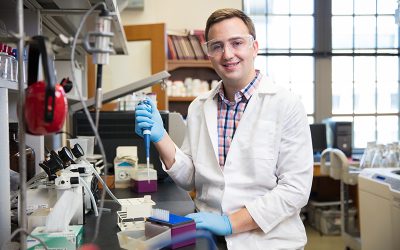“There are a lot of YouTubers out there who are popular and using products spontaneously, which I believe is more powerful with Millennials.”

Capitalizing on Viral Videos
Six students enter the Walton College Behavioral Business Research Lab, painted a soothing peach color to put them at ease. They sit down in front of laptops, answer some questions, watch a video, check off a few follow up questions and then they’re done. Or are they?
As they file out, Jonny Schultz, an honors senior double majoring in supply chain management and economics, gives each student five dollars for participating in the survey and casually waves at a pile of Nestlé Crunch, Kit Kat and Hershey chocolate bars on the table in front of him.
“There’s a lot of candy left over from an experiment last week – you can buy a bar for fifty cents each if you’d like,” he says. Some of the students load up, while others hesitate, then decline.
Schultz is tracking their responses, and most critically, their decision to buy or not to buy the candy bars as part of his honors thesis, which looks at how product placement in YouTube videos impacts consumer behavior. Product placement in movies and television shows has been extensively researched, but there is much work to be done on YouTube, which boasts more than one billion unique users each month. Schultz’ focus on consumer response to spontaneous versus sponsored product placement on YouTube breaks new ground.
“There are a lot of YouTubers out there who are popular and using products spontaneously, which I believe is more powerful with Millennials,” Schultz said. “I think companies haven’t fully tapped into the potential of that market.” He points to a 2005 YouTube video where Stephen Voltz and Fritz Grobe combined Diet Coke and Mentos to produce fizzing fountains of spray. The video went viral, but the two companies initially hesitated to seize on the phenomenon.
“It’s crazy how big that video went, but Coke and Mentos didn’t respond well,” Schultz said. “What if they’d combined Diet Coke and Mentos in sales displays? Sales would have tripled in those few weeks.”
For his study, Schultz created two versions of a YouTube video where he and a friend play a Kit-Kat-powered game of Go. The control group watched a video prefaced with a note and announcement that the video is sponsored by Kit Kat, while the test group watched the same video without a disclosure of sponsorship. The preliminary questions were designed to capture demographic information on the participants and their experiences and perceptions of the products in the video, while follow up questions gauged their preference and purchasing intent for the product.
Schultz credits mentor Vikas Anand, professor and chair of the Department of Management, with the idea of conducting the study in the Walton Behavioral Lab.
“That allowed us to track actual purchasing behavior, not just intent,” he said. Schultz surveyed more than 100 participants ranging in age from 17 to 50 years old. His results did not show whether or not having an ad led to higher consumption of the candy; he credits this to the relatively small sample size. His results did come into sharper focus when he filtered his data set for participants who tested high for trusting internet videos – about half of his sample. Of the 25 in this group who saw the video with an ad noting sponsorship, not one bought the Kit Kat bar.

Jonny Schultz tracked consumer response to videos featuring Kit Kat bars. He found that spontaneous product placement sparked more sales.
“What that tells me is that when they saw that ad, maybe they thought the YouTube character was dishonest, or selling out,” Schultz said. “If the product placement is spontaneous, they trust characters more.” He also found that the stronger the relationship that viewers felt with characters in the video, the more Kit Kats they would buy.
That’s a key finding for companies, Schultz said. “They should look for YouTubers with a strong community, those with the highest engagement with their audience,” he said. He also points to image recognition software that could help companies find unsponsored plugs for their products and capitalize on them.
“That would be a cool way for companies to improve sales forecasting and have their ear to the ground on sales trends,” Schultz said.
Schultz’ research was supported by a State Undergraduate Research Fellowship.
More Field Notes Stories
Pyramid Power
Garret Gardenhire, Kevin Le and Matt Annis monitor their solar-powered food dehydrator, designed to combat food insecurity in developing countries. Freshmen honors engineering students Garret Gardenhire, Kevin Le and Matt Annis inherited a simple machine and a big...
Growing Up and Growing Old: Developing Research Skills in the Aging Lab
Allen straps on a knee brace, designed to mimic the effects of arthritis on the joints; she hopes that her research will lead to a greater awareness of ageist attitudes.by Samantha Kirby “What?” I asked. “What?” My hearing was poor. I turned toward the speaker, but...
Double Duty for Future MD
As part of his biochemistry thesis, Will Pohlman developed a dye technique that may prove useful to pharmacological companies. Biochemistry and animal science proved to be the perfect double major for Sturgis Fellow Will Pohlman, who dreamed about a career...
Fashion for the 21st-Century Flower Child
“They’re incredible! Katie and Laura took a dream I had and made it happen – they’ve opening up a whole new area of research for our program.” The theme was “Futuristic Floral” and the student designers rose to the challenge: the models who strutted down the runways...
Big Picture Data
“Hannah has painted something that everyone can respond to on a personal level, that offers people a way into a place to see it differently.” Rain or shine, at 7 a.m. every Tuesday for five months honors landscape architecture major Hannah Moll showed up, camera in...






